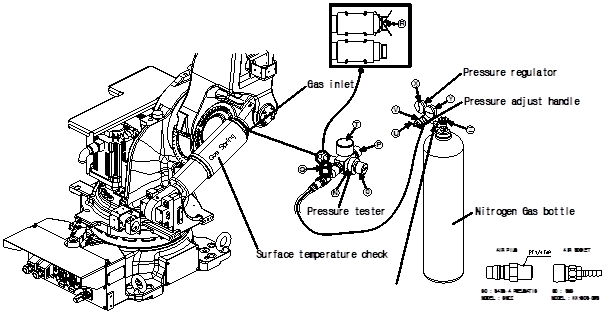9.2.2. When the Pressure of the Nitrogen Gas Bombe is 150 Bar or Below (Replenishing the Gas by Using the Booster)
9.2.2. When the Pressure of the Nitrogen Gas Bombe is 150 Bar or Below (Replenishing the Gas by Using the Booster)
(1) Set the robot to the 90° posture, and cut off the power of the controller.
(2) Remove the plug installed to the gas inlet of the gas spring.
(3) Check that the bleed valve Pand shut-off valve Qof the pressure tester are closed (locked clockwise.)
(4) Turn the knob Ocounterclockwise to prevent the release Rfrom protruding.
(5) Turn the knob Nof the pressure tester clockwise to completely connect it to the gas inlet.
(6) Check whether the handle U, shut-off valve ⓦ, knob ⓢ (the knob of the air hose owned by the customer), and shut-off valve Qare locked.
(7) Connect the screw of the connection part of the regulator to the screw of the nitrogen gas bombe.
(The connection parts of hoses should be connected to each connection inlet.)
Each country has different specifications for the screw of the nitrogen bombe, you should purchase a regulator that meets the specifications for the screw of the nitrogen bombe.
(8) The gauge Xindicates the set gas pressure of the nitrogen gas bombe, and the gauge Yindicates the pressure of the nitrogen gas bombe.
(9) Open the knob Zof the nitrogen gas bombe, and then turn the handle U of the regulator (V)to set the set gas pressure (the set gas pressures are shown in Table 9.1 Pressure For Each Gas Spring Surface Temperature – The Set Gas Pressure.)
(10) Open the shut-off valve ⓦ of the hose connected to the regulator Vand slowly turn the shut-off valve Qto be connected to the pressure tester counterclockwise until the pointer of the pressure gauge Tmatches the pointer of the gauge X.
(11) Connect the connection part of the air hose to the booster and then open the knob ⓢ (the knob of the air hose owned by the customer)to operate the booster.
Charge until the pointer of the pressure gauge Treaches the set pressure.
※ During the charging, the minimum air pressure should be 5 bar or more
Replace the nitrogen gas bombe when the residual pressure is 30 bar or less.
(12) When the set pressure is reached, close the shut-off value Qand then open the bleed valve Pto release the residual pressure inside the pressure tester.
(Do not unscrew the bleed valve Pmore than 360°.)
(13) Close the bleed valve Pand turn the knob Oclockwise little by little while checking that the pointer of the pressure gauge Tmatches the set pressure. If they are matching, stop the work.
Take precautions not to allow the release pin Rto go inside excessively and damage the check valve mounted on the gas spring.
(14) When the set pressure is exceeded, you should adjust the gas pressure to the desired pressure by opening and closing the bleed valve Plittle by little.
(15) Turn the knob Ocounterclockwise to retreat the release pin R.
(16) When the pressure is checked, the bleed valve Pshould be opened to completely release the residual pressure inside the pressure tester.
(17) Close the knob ⓢ of the air hose and separate it from the booster.
(18) Close the shut off valve ⓦ of the hose connected to the regulator and close the handle U.
(19) Close the knob Zof the nitrogen gas bombe and separate the hose connected to the regulator Vfrom the booster. After that, open the shut-off value to completely release the residual pressure remaining inside.
(20) Separate the shut-off valve connection part from the pressure tester.
(21) Turn the knob Nof the tester pressure counterclockwise to disconnect from the gas spring.
Connect the G1/8 plug to the gas spring.
After charging the gas, allow about 30 minutes for the gas temperature to return to room temperature before the use.

Figure 9.3 Replenishing the Gas of the Gas Spring by Using the Booster
The gas replenishing kit and the booster may vary in shape and name depending on the types, so please refer to the manual enclosed when you purchased them. |